Influence of Fluorine Nano-Coating on Cutting Force and Surface Roughness of Wood–Plastic Composites During Milling
Abstract
1. Introduction
2. Materials and Methods
2.1. Material
2.1.1. Workpiece Materials
2.1.2. Cutting Tools
2.2. Methods
2.2.1. Experiment Setup
2.2.2. Experimental Design
3. Results and Discussion
3.1. Influence of Cutting Speed, Cutting Depth, and Tool Surface Treatment on Cutting Force
3.2. Variance Analysis of Factors Affecting Cutting Force
3.3. Influence of Cutting Speed, Cutting Depth, and Tool Surface Treatment on Machining Quality
3.4. Variance Analysis of Factors Affecting Machining Quality
4. Conclusions
- (1)
- Cutting force tends to decrease as the cutting speed increases, and it tends to rise with a deeper cutting depth. For all cutting conditions tested, the cutting force of coated tools was consistently lower than that of uncoated tools, which indicates that the coating of cutting tools plays an important role in reducing cutting forces;
- (2)
- Surface roughness of the machined surface decreases with increasing cutting speed and increases with increasing cutting depth. For all cutting conditions tested, the surface roughness of workpieces machined with coated tools was consistently lower than that of workpieces machined with uncoated tools, which reveals that the coating has a beneficial impact on reducing surface roughness and improving machining quality;
- (3)
- The ANOVA showed that cutting depth is the most influential factor on both cutting force and machining quality, followed by cutting speed and tool surface treatment. However, the percentage contributions of cutting speed and tool surface treatment to the surface roughness of the workpiece are 23.2% and 22.5%, respectively, which indicates that they are also important factors influencing the quality of machining.
Author Contributions
Funding
Institutional Review Board Statement
Informed Consent Statement
Data Availability Statement
Conflicts of Interest
References
- Moritzer, E.; Richters, M. Characterization of wood-filled thermoplastic polyurethanes for the injection molding process. J. Appl. Polym. Sci. 2021, 138, 50968. [Google Scholar] [CrossRef]
- Gardner, D.J.; Han, Y.; Wang, L. Wood–plastic composite technology. Curr. For. Rep. 2015, 1, 139–150. [Google Scholar] [CrossRef]
- Segerholm, B.K.; Vellekoop, S.; Wålinder, M.E. Process–related mechanical degradation of the wood component in high–wood–content wood–plastic composites. Wood Fiber Sci. 2012, 44, 145–154. [Google Scholar]
- Fang, L.; Xiong, X.; Wang, X.; Chen, H.; Mo, X. Effects of surface modification methods on mechanical and interfacial properties of high–density polyethylene–bonded wood veneer composites. J. Wood Sci. 2017, 63, 65–73. [Google Scholar] [CrossRef]
- Candelier, K.; Atli, A.; Alteyrac, J. Termite and decay resistance of bioplast–spruce green wood–plastic composites. Eur. J. Wood Wood Prod. 2019, 77, 157–169. [Google Scholar] [CrossRef]
- Xiong, X.; Niu, Y.; Zhou, Z.; Ren, J. Development and application of a new flame–retardant adhesive. Polymers 2020, 12, 2007. [Google Scholar] [CrossRef]
- Xiong, X.; Yue, X.; Wu, Z. Current Status and Development Trends of Chinese Intelligent Furniture Industry. J. Renew. Mater. 2023, 11, 3. [Google Scholar] [CrossRef]
- Lu, D.; Xiong, X.; Lu, G.; Gui, C.; Pang, X. Effects of NaOH/H2O2/Na2SiO3 bleaching pretreatment method on wood dyeing properties. Coatings 2023, 13, 233. [Google Scholar] [CrossRef]
- Shih, Y.F.; Chang, C.W.; Hsu, T.H.; Dai, W.Y. Application of Sustainable Wood-Plastic Composites in Energy-Efficient Construction. Buildings 2024, 14, 958. [Google Scholar] [CrossRef]
- Ribeiro, L.S.; Stolz, C.M.; Amario, M.; Silva, A.L.N.D.; Haddad, A.N. Use of post-consumer plastics in the production of wood-plastic composites for building components: A Systematic Review. Energies 2023, 16, 6549. [Google Scholar] [CrossRef]
- Qi, X.; Shang, Y.; Ding, Z.; Wei, W. Particularities and research progress of the cutting machinability of wood–plastic composites. Mater. Today Commun. 2023, 37, 106924. [Google Scholar] [CrossRef]
- Guo, X.L.; Liu, H.N.; Gao, W.; Cao, P.X.; Chinakhov, D.A. Effects of spindle speed on surface qualities in WPC sawing. Appl. Mech. Mater. 2010, 33, 487–491. [Google Scholar] [CrossRef]
- Kazlauskas, D.; Jankauskas, V. Woodworking tools: Tribological problems and directions of solutions. In Proceedings of the 9th International Conference BALTTRIB, Akademija, Kaunas, Lithuania, 16–17 November 2017; pp. 178–187. [Google Scholar]
- Kamperidou, V.; Aidinidis, E.; Barboutis, I. Impact of structural defects on the surface quality of hardwood species sliced veneers. Appl. Sci. 2020, 10, 6265. [Google Scholar] [CrossRef]
- Warcholinski, B.; Gilewicz, A. Surface engineering of woodworking tools, a review. Appl. Sci. 2022, 12, 10389. [Google Scholar] [CrossRef]
- Bai, Q.; Yao, Y.; Chen, S. Research and development of polycrystalline diamond woodworking tools. Int. J. Refract. Met. Hard Mater. 2002, 20, 395–400. [Google Scholar] [CrossRef]
- Warcholinski, B.; Gilewicz, A. Multilayer coatings on tools for woodworking. Wear 2011, 271, 2812–2820. [Google Scholar] [CrossRef]
- Nadolny, K.; Kapłonek, W.; Sutowska, M.; Sutowski, P.; Myśliński, P.; Gilewicz, A.; Warcholiński, B. Moving towards sustainable manufacturing by extending the tool life of the pine wood planing process using the AlCrBN coating. Sustain. Mater. Technol. 2021, 28, e00259. [Google Scholar] [CrossRef]
- Darmawan, W.; Usuki, H.; Rahayu, I.S.; Gottlöber, C.; Marchal, R. Wear characteristics of multilayer–coated cutting tools when milling particleboard. For. Prod. J. 2010, 60, 615–621. [Google Scholar] [CrossRef]
- Pangestu, K.T.P.; Darmawan, W.; Nandika, D.; Wahyudi, I.; Dumasari, L.; Usuki, H. Performance of coated tungsten carbide in milling composite boards. Wood Res.–Slovak 2021, 66, 606–620. [Google Scholar]
- Darmawan, W.; Tanaka, C.; Usuki, H.; Ohtani, T. Performance of coated carbide tools when grooving wood–based materials: Effect of work materials and coating materials on the wear resistance of coated carbide tools. J. Wood Sci. 2001, 47, 94–101. [Google Scholar] [CrossRef]
- Kazlauskas, D.; Jankauskas, V.; Tučkutė, S. Research on tribological characteristics of hard metal WC–Co tools with TiAlN and CrN PVD coatings for processing solid oak wood. Coatings 2020, 10, 632. [Google Scholar] [CrossRef]
- Sheikh–Ahmad, J.Y.; Morita, T. Tool coatings for wood machining: Problems and prospects. For. Prod. J. 2002, 52, 43. [Google Scholar]
- Faga, M.G.; Settineri, L. Innovative anti–wear coatings on cutting tools for wood machining. Surf. Coat. Technol. 2006, 201, 3002–3007. [Google Scholar] [CrossRef]
- Chivavibul, P.; Watanabe, M.; Kuroda, S.; Komatsu, M. Evaluation of HVOF–sprayed WC–Co coatings for wood machining. Surf. Coat. Technol. 2008, 202, 5127–5135. [Google Scholar] [CrossRef]
- Jiang, S.; Buck, D.; Tang, Q.; Guan, J.; Wu, Z.; Guo, X.; Wang, X. Cutting force and surface roughness during straight–tooth milling of Walnut wood. Forests 2022, 13, 2126. [Google Scholar] [CrossRef]
- Branowski, B.; Zabłocki, M.; Sydor, M. Experimental analysis of new furniture joints. Bioresources 2018, 13, 370–382. [Google Scholar] [CrossRef]
- Wei, H.; Guo, X.; Zhu, Z.; Cao, P.; Wang, B.; Ekevad, M. Analysis of cutting performance in high density fiberboard milling by ceramic cutting tools. Wood Res. 2018, 63, 455–466. [Google Scholar]
- Li, R.; Yao, Q.; Wang, X. Optimization of cutting power and power efficiency during particleboard helical milling. Materwiss. Werkstofftech. 2023, 54, 158–167. [Google Scholar] [CrossRef]
- Li, R.; He, C.; Xu, W.; Wang, X. Modeling and optimizing the specific cutting energy of medium density fiberboard during the helical up–milling process. Wood Mater. Sci. Eng. 2023, 18, 464–471. [Google Scholar] [CrossRef]
- Qiu, X.H. Research on Cutting Performance of Nano-Fluorine Coating Tools in Milling Particleboard. Master Thesis, Nanjing Forestry University, Nanjing, China, 2018. [Google Scholar]
- Song, M.; Buck, D.; Yu, Y.; Du, X.; Guo, X.; Wang, J.; Zhu, Z. Effects of Tool Tooth Number and Cutting Parameters on Milling Performance for Bamboo–Plastic Composite. Forests 2023, 14, 433. [Google Scholar] [CrossRef]
- Chen, B.; Yu, X.; Hu, W. Experimental and numerical studies on the cantilevered leg joint and its reinforced version commonly used in modern wood furniture. BioResources 2022, 17, 3952. [Google Scholar] [CrossRef]
- Hu, W.; Yu, R. Study on the strength mechanism of the wooden round–end mortise–and–tenon joint using the digital image correlation method. Holzforschung 2024, 78, 519–530. [Google Scholar] [CrossRef]
- Hu, W.; Yu, R.; Luo, M.; Konukcu, A.C. Study on tensile strength of single dovetail joint: Experimental, numerical, and analytical analysis. Wood Mater. Sci. Eng. 2023, 18, 1478–1486. [Google Scholar] [CrossRef]
- Zhang, N.; Mao, Y.; Wu, S.; Xu, W. Effects of the ball milling process on the particle size of graphene oxide and its application in enhancing the thermal conductivity of wood. Forests 2022, 13, 1325. [Google Scholar] [CrossRef]
- Li, R.; Yang, F.; Wang, X. Modeling and predicting the machined surface roughness and milling power in Scot’s pine helical milling process. Machines 2022, 10, 331. [Google Scholar] [CrossRef]
- Li, R.; Yao, Q.; Xu, W.; Li, J.; Wang, X. Study of cutting power and power efficiency during straight–tooth cylindrical milling process of particle boards. Materials 2022, 15, 879. [Google Scholar] [CrossRef]
- Kuljich, S.; Hernández, R.E.; Llavé, A.M.; Koubaa, A. Effects of cutting direction, rake angle, and depth of cut on cutting forces and surface quality during machining of balsam fir. Wood Fiber Sci. 2013, 45, 195–205. [Google Scholar]
- Zhang, Y.; Fang, L.; Chen, J. Influence of micron–sized oligomeric semisiloxane modification on surface properties of veneer and interfacial adhesion of EVA film/poplar plywood. Wood Mater. Sci. Eng. 2024, 20, 328–337. [Google Scholar] [CrossRef]
- Li, H.; You, L.; Tian, Y.; Guo, J.; Fang, X.; Zhou, C.; Su, Y.Q. DPAGT1-Mediated Protein N-Glycosylation Is Indispensable for Oocyte and Follicle Development in Mice. Adv. Sci. 2020, 7, 2000531. [Google Scholar] [CrossRef]
- Li, R.; He, C.; Wang, X. Effects of processing parameters on mass loss and coating properties of poplar plywood during CO2 laser modification. Eur. J. Wood Wood Prod. 2022, 80, 899–906. [Google Scholar] [CrossRef]
- Hu, W.; Zhao, Y.; Xu, W.; Liu, Y. The Influences of Selected Factors on Bending Moment Capacity of Case Furniture Joints. Appl. Sci. 2024, 14, 10044. [Google Scholar] [CrossRef]

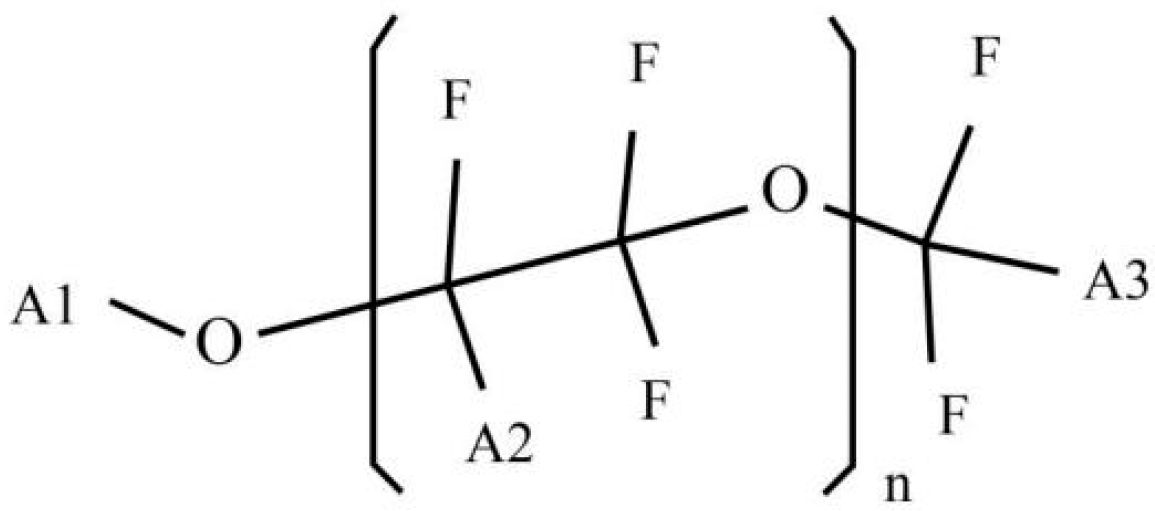
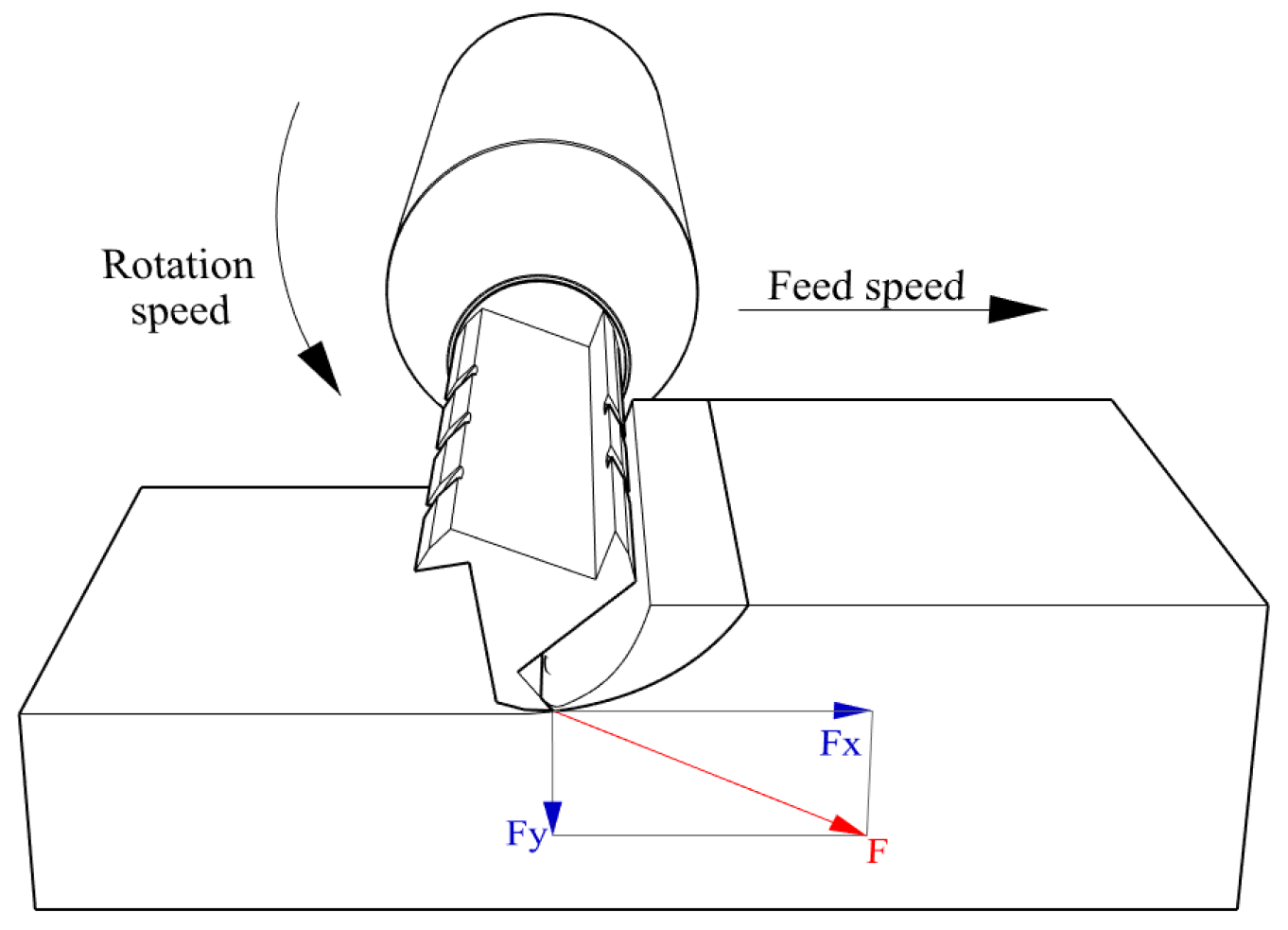
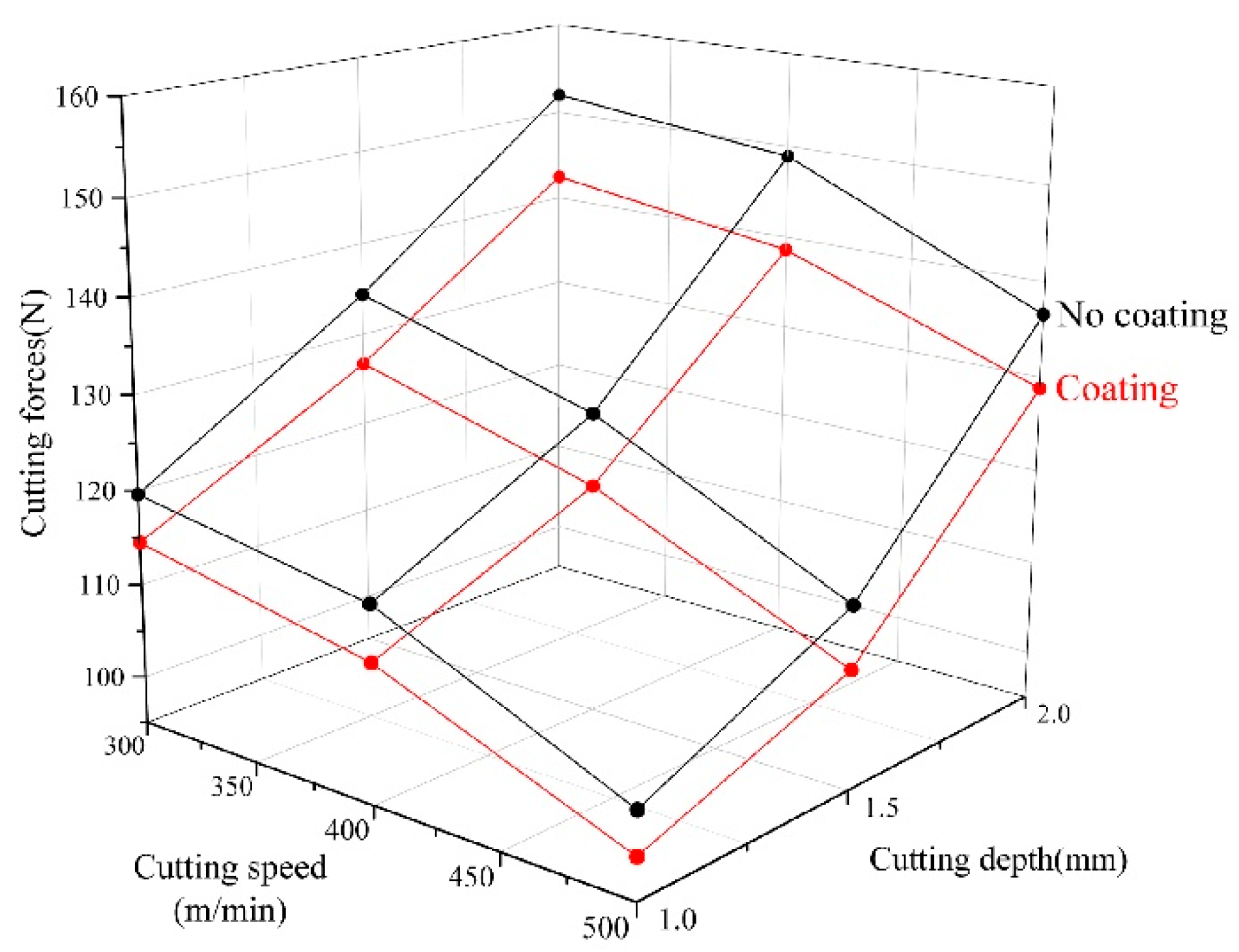

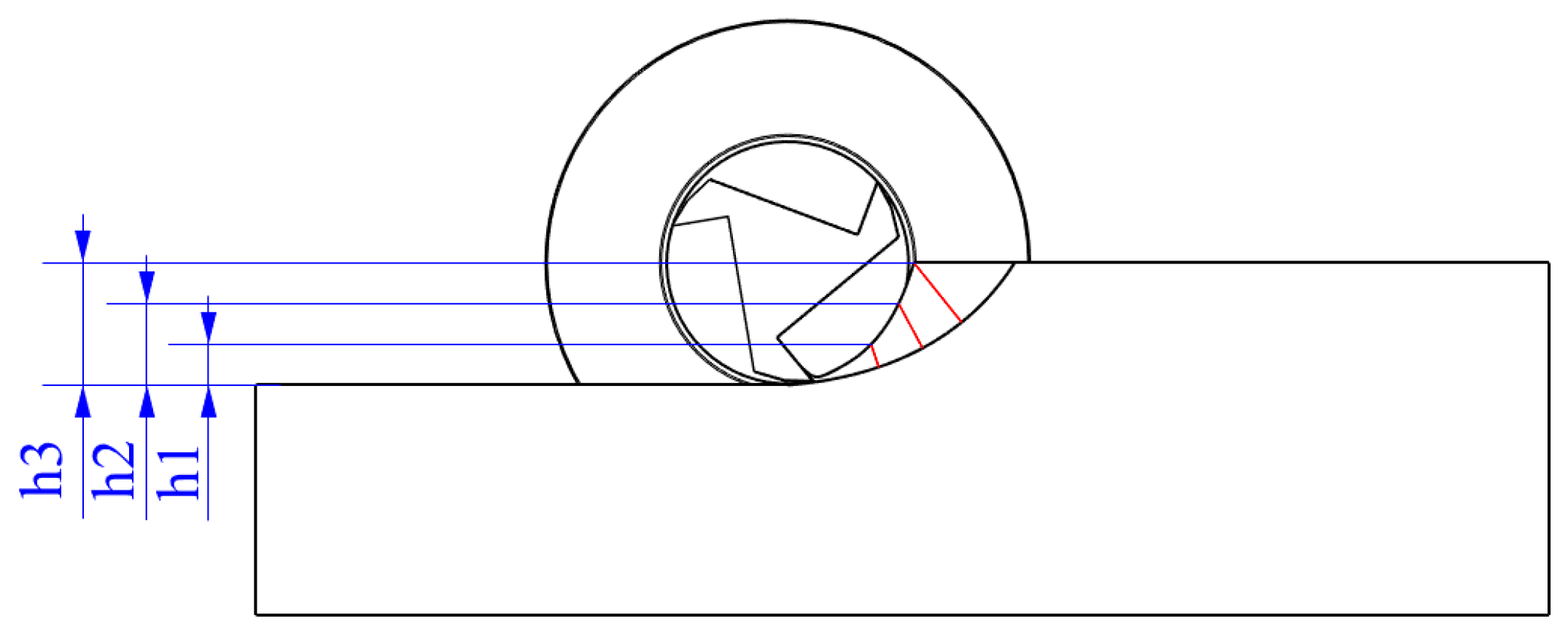
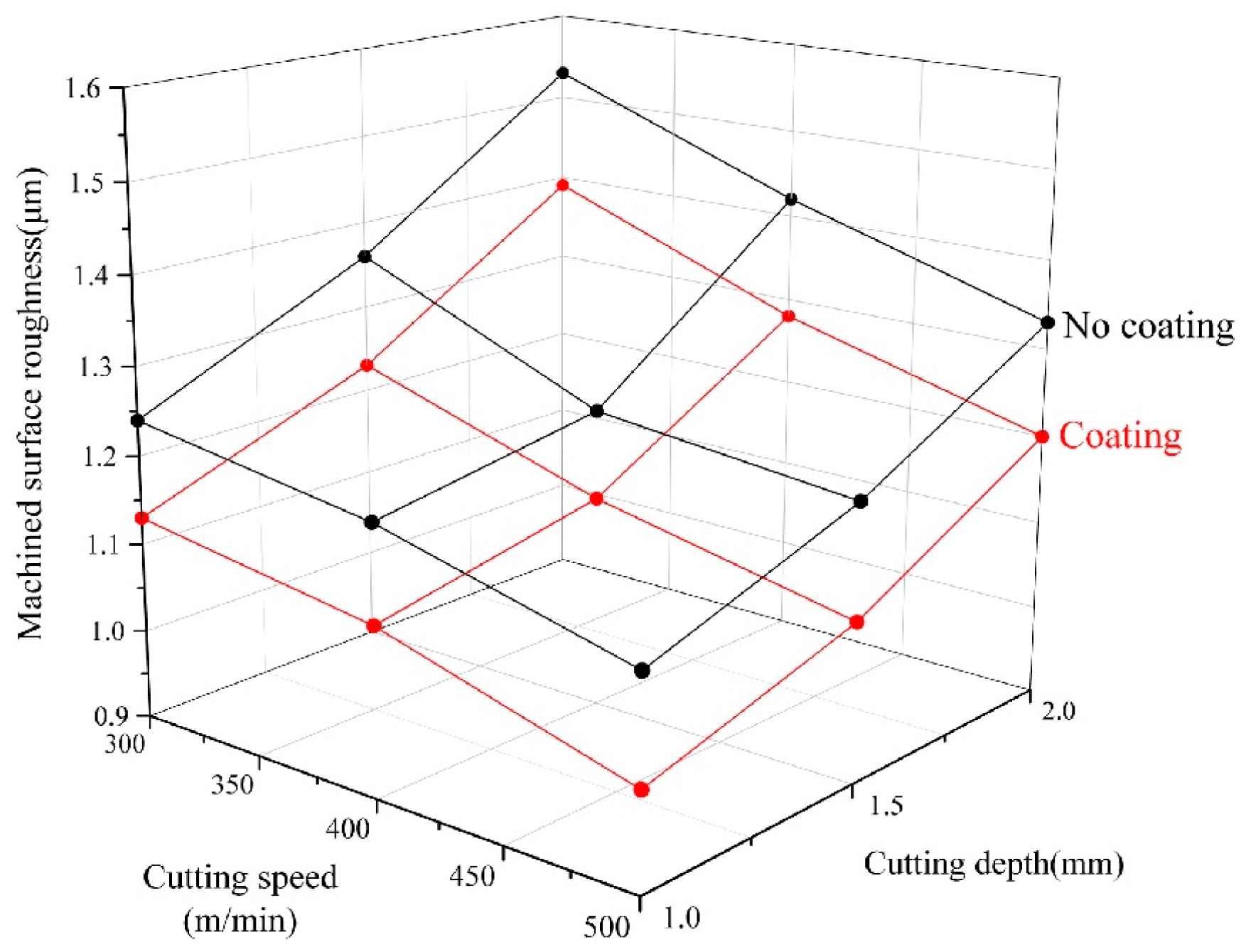

| Tool Surface | Rake Angle γ (°) | Wedge Angle β (°) | Clearance Angle α (°) | Edge Length (mm) |
|---|---|---|---|---|
| No coating | 15 | 50 | 25 | 22 |
| Coating | 15 | 50 | 25 | 22 |
| Test Number | Surface Treatment | Cutting Speed (m/min) | Cutting Depth (mm) | Cutting Forces (N) | Surface Roughness (μm) |
|---|---|---|---|---|---|
| 1 | Coating | 300 | 1.0 | 114.5 | 1.13 |
| 2 | Coating | 400 | 1.0 | 109.6 | 1.09 |
| 3 | Coating | 500 | 1.0 | 99.4 | 1.01 |
| 4 | Coating | 300 | 1.5 | 126.7 | 1.23 |
| 5 | Coating | 400 | 1.5 | 119.4 | 1.14 |
| 6 | Coating | 500 | 1.5 | 107.5 | 1.08 |
| 7 | Coating | 300 | 2.0 | 142.5 | 1.39 |
| 8 | Coating | 400 | 2.0 | 138.6 | 1.28 |
| 9 | Coating | 500 | 2.0 | 128.8 | 1.2 |
| 10 | No coating | 300 | 1.0 | 119.6 | 1.24 |
| 11 | No coating | 400 | 1.0 | 115.5 | 1.2 |
| 12 | No coating | 500 | 1.0 | 103.9 | 1.13 |
| 13 | No coating | 300 | 1.5 | 134.4 | 1.36 |
| 14 | No coating | 400 | 1.5 | 127.1 | 1.24 |
| 15 | No coating | 500 | 1.5 | 114.1 | 1.21 |
| 16 | No coating | 300 | 2.0 | 152 | 1.53 |
| 17 | No coating | 400 | 2.0 | 148.9 | 1.42 |
| 18 | No coating | 500 | 2.0 | 136.6 | 1.33 |
| Source | df | Sum of Squares | Mean Square | % Contrib. | F-Value | p-Value |
|---|---|---|---|---|---|---|
| Tool surface treatment | 1 | 235.445 | 235.445 | 5.744 | 90.347 | <0.0001 * |
| Cutting speed | 2 | 863.898 | 431.949 | 21.185 | 165.751 | <0.0001 * |
| Cutting depth | 2 | 2922.674 | 1461.337 | 71.978 | 560.755 | <0.0001 * |
| Model | 5 | 4022.017 | 804.403 | 98.907 | 308.671 | <0.0001 * |
| Residual | 12 | 31.272 | 2.606 | 1.093 | ||
| Total | 17 | 4053.289 | 100 |
| Source | df | Sum of Squares | Mean Square | % Contrib. | F-Value | p-Value |
|---|---|---|---|---|---|---|
| Tool surface treatment | 1 | 0.068 | 0.068 | 22.525 | 147.852 | <0.0001 * |
| Cutting speed | 2 | 0.070 | 0.035 | 23.155 | 76.476 | <0.0001 * |
| Cutting depth | 2 | 0.157 | 0.079 | 51.714 | 169.572 | <0.0001 * |
| Model | 5 | 0.296 | 0.059 | 97.395 | 127.990 | <0.0001 * |
| Residual | 12 | 0.006 | 0.00046 | 2.604 | ||
| Total | 17 | 0.302 | 100 |
Disclaimer/Publisher’s Note: The statements, opinions and data contained in all publications are solely those of the individual author(s) and contributor(s) and not of MDPI and/or the editor(s). MDPI and/or the editor(s) disclaim responsibility for any injury to people or property resulting from any ideas, methods, instructions or products referred to in the content. |
© 2025 by the authors. Licensee MDPI, Basel, Switzerland. This article is an open access article distributed under the terms and conditions of the Creative Commons Attribution (CC BY) license (https://creativecommons.org/licenses/by/4.0/).
Share and Cite
Du, X.; Buck, D.; Guan, J.; Liu, K.; Zhu, Z. Influence of Fluorine Nano-Coating on Cutting Force and Surface Roughness of Wood–Plastic Composites During Milling. Coatings 2025, 15, 574. https://doi.org/10.3390/coatings15050574
Du X, Buck D, Guan J, Liu K, Zhu Z. Influence of Fluorine Nano-Coating on Cutting Force and Surface Roughness of Wood–Plastic Composites During Milling. Coatings. 2025; 15(5):574. https://doi.org/10.3390/coatings15050574
Chicago/Turabian StyleDu, Xiaohang, Dietrich Buck, Jun Guan, Kai Liu, and Zhaolong Zhu. 2025. "Influence of Fluorine Nano-Coating on Cutting Force and Surface Roughness of Wood–Plastic Composites During Milling" Coatings 15, no. 5: 574. https://doi.org/10.3390/coatings15050574
APA StyleDu, X., Buck, D., Guan, J., Liu, K., & Zhu, Z. (2025). Influence of Fluorine Nano-Coating on Cutting Force and Surface Roughness of Wood–Plastic Composites During Milling. Coatings, 15(5), 574. https://doi.org/10.3390/coatings15050574





